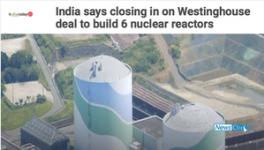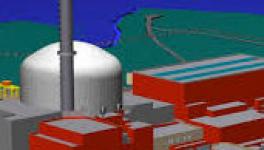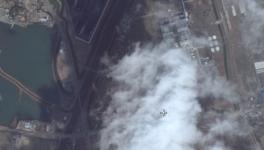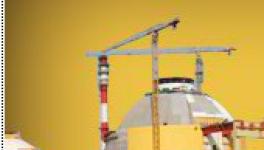The Kudankulam stand-off: A way out
Protests against the two Russian VVER nuclear reactors being built in Kudankulam were low key all along, but after the Fukushima accident, this opposition has gained momentum.
The major reason for the opposition was always the concern for the safety of the Russian reactors and the fear that their operation will severely reduce the fishing potential in near-coastal waters. But, of late, these protests appear to be widening into a struggle to oppose nuclear power plants in general, and not just the Russian VVERs. This is reflected also in the composition of the Advisory Expert Panel recently formed by the People’s Movement Against Nuclear Energy, which includes some established anti-nuclear activists. This transformation does not augur well for the future of India’s nuclear power programme.
The construction of the first unit at Kudankulam started in March 2002. Under this contract, the Russians are committed to supply the enriched fuel for the lifetime of these reactors and India can keep the spent fuel and reprocess it when we wish. These terms are quite liberal and different from the stringent controls the Americans imposed in 2008 under the Hyde Act and the 123 Agreement.
To secure the India-US nuclear deal, our prime minister gave a unilateral assurance to the US, France and Russia that — subsequent to the Nuclear Suppliers Group granting exemption to India — we shall purchase a sizeable number of nuclear reactors from these three countries. It is to fulfill this promise that the government is aggressively pursuing a policy of reactor imports.
Article continues below the advertisement...
No overall nuclear power policy exists in India, and the PM now feels there is no need to frame any such policy since he has already taken a decision to import 40,000 MWe worth of reactors over the next 20 years. All the successive chairmen and scientific members of the last three atomic energy commissions have unethically supported the prime minister in his illogical decision to import reactors without even carrying out any cost or safety appraisals, and thereby helped discard by the wayside all plans to expand the indigenous pressurised heavy water reactor fleet.
The first Russian VVER-1000 reactor went into commercial operation in 1981 at the Novovoronezh power plant in Russia. There are 11 VVER-1000 reactors safely operating in Russia today, with an additional seven such reactors operating in Bulgaria, the Czech Republic, China and Iran. There are two more under construction in Bulgaria and two just contracted by Bangaladesh last week. In addition, there are several earlier generation VVER-440 MWe and VVER-210/365 MWe units still in operation in Russia, where the design has already been uprated to VVER-1200 MWe units, a few of which are in late stages of construction.
Many of the initial VVER-1000 reactors are of the V-320 version. As notable improvements are made, the Russian design bureau gives each updated design a new version number. An export design of later vintage is the V-392 version, with enhanced safety and seismic features, which is the basis for the AES-92 now being commissioned in Kudankulam. These reactors have modern western control and instrumentation systems and a molten-core catcher to take care of beyond-design-basis accidents. A slightly different version (AES-91) of the same reactor was supplied to the Tianwan Station in China and the two units there have been commercially operating since 2006 and 2007. These two Chinese reactors also have similar core catchers. Construction of two further VVER-1000 units is about to start at Tianwan in 2012.
In view of the above background, my request is that those who are protesting against the VVER-1000 reactors need to go into the details of the worldwide experience from operating VVER-1000 reactors, objectively debate their merits and demerits, and assess their safety. Unlike Dr APJ Abdul Kalam, I hesitate to pronounce my own judgment on the absolute and comparative safety of these reactors, though I am an academically qualified nuclear engineer with more than 53 years of experience in operation, design and safety analysis of nuclear reactor systems in the US and in India. Lasting conviction about Kudankulam safety can only come from the protesters themselves studying the issues to the best of their ability with an impartial attitude and any attempt to impose outside views on them is likely to induce mistrust.
In conclusion, may I request the prime minister, his nuclear establishment, and the Kudankulam protesters to consider the following five-point action plan:
1. I agree with the DAE/NPCIL statement that preventing the minimum number of engineers and technicians from entering the plant could potentially damage, for example, critical subsystems like electronic and computerised instrumentation & controls, turbine subsystems, variety of pumps and chemical purifiers, all of which have to be kept continuously operational and monitored. These are technical issues which most of the protesters do not seem to understand. What they really need is an assurance that the reactor would not be taken to nuclear criticality without their prior knowledge and consent. This can be achieved by both sides agreeing that nuclear fuel loading into the reactor shall be done only with mutual agreement. After reaching a written agreement on this issue with the DAE and the state government, the protesters must allow free access to DAE and contract personnel into the project premises.
2. For the Phase-1 Kudankulam Project, consisting Units 1&2, it is disputed whether an appropriate Environmental Impact Assessment report, in strict conformity with the Ministry of Environment and Forests’ EIA Guidance Manual of March 2010, has ever been prepared, translated into Tamil and distributed to the local population. It also appears that no public hearing on such an EIA report has been organised by NPCIL. As a first step, therefore, the protesters and NPCIL authorities must jointly assess the adequacy of the existing EIA, revise it if necessary and translate it into Tamil, and conduct orderly public hearings thereafter.
3. The local people must have an opportunity to study the Preliminary and Final Safety Analysis Reports for the Kudankulam plant to understand the detailed safety evaluations done by NPCIL, and their conclusions. I realise that certain minimum set of facts, figures, and other details from the actual safety analysis reports may have to be kept away from public knowledge before releasing these reports because of physical security implications. The protesters too must understand that such censoring by the NPCIL is absolutely essential from a public safety standpoint. A sanitised version of these reports may be made available on the NPCIL website.
4. All NPCIL efforts, including civil works and ordering of equipment, related to setting up the future four VVERs (Units 3 to 6) at Kudankulam or elsewhere should be stopped forthwith. Whether or not any foreign nuclear power reactors are to be imported, including the future VVERs, is a matter to be decided only after the government prepares a comprehensive nuclear power policy and gets it debated in the Parliament. An integral part of this policy must be to re-emphasise the indigenous three-stage Bhabha Plan of the past, and to give priority support to the pressurised heavy water reactor, advanced heavy water reactor and fast breeder reactor programmes aimed at thorium utilisation. All existing plans and agreements to import reactors must be held in abeyance till such a comprehensive plan is discussed and concurred in Parliament.
5. The newly introduced Nuclear Safety Regulatory Authority Bill, 2011, is a totally inadequate legislation for creating an independent and transparent safety regulation agency. This bill must be revised drastically to allow the NSRA to operate free from the threats and manipulations of the government. The bill must also include the provision for creating a permanent Local Information Committee at each nuclear site in the country, for conducting regular and periodic exchange of information and data on matters related to public safety and the environment, between the site authorities and local representatives. In addition, the minimum required provisions for ‘whistleblower protection’ for nuclear workers must be built into the NSRA Act, without waiting for a national law in this matter to emerge in the future.
Resolution of the current Kudankulam imbroglio would require face-to-face meetings between the NPCIL authorities, the DAE expert committee, and the leaders of the protest, without the atmosphere being vitiated through the participation of staunch votaries or die-hard opponents of nuclear power from either side.
Both sides must also clearly recognise that, after already spending about Rs15,000 crores of tax payers’ money, the nation is not in any mood to abandon the Kudankulam Units 1&2 unless evidence beyond any doubt can be presented to establish that these two VVER units are distinctly dangerous in comparison to all VVER-1000 reactors safely operating in the world since 1981. Let us hope that attention can be first focused on items 1, 2, and 3 above, since the work should proceed towards fuelling Unit-1 only after these three steps are completed to mutual satisfaction.
The author is a former chairman, Atomic Energy Regulatory Board, Government of India
Courtesy: DNA
Image Courtesy: npcil.nic.in
Get the latest reports & analysis with people's perspective on Protests, movements & deep analytical videos, discussions of the current affairs in your Telegram app. Subscribe to NewsClick's Telegram channel & get Real-Time updates on stories, as they get published on our website.























